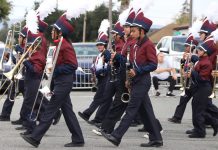Class sizes at San Benito High School are slightly larger this
year compared to last, with a school-wide average of 30.7 students
per class, according to a report released by the school last
week.
Hollister – Class sizes at San Benito High School are slightly larger this year compared to last, with a school-wide average of 30.7 students per class, according to a report released by the school last week.
That is up from 29.8 last year, and is over three more students per classroom than California’s 2004-2005 statewide average of 27.3, or over 10 percent higher, according to the most recent statistics available from the California Department of Education.
But the difference could be even higher.
The California Department of Education has a different formula for computing class size, including not counting smaller special education classes when figuring average class size.
As a result, its figures are usually higher than the district’s statistics, suggesting that the gap between class size at San Benito High School and the state average could be even higher.
For example, according to the CDE, San Benito High School’s average class size last year was 31.5 students, compared to the school’s reported figure of 29.8. Figures for this year from the CDE are not yet available.
SBHS Principal Debbie Padilla put a positive face on the report.
“It’s not a huge increase, but across the board the numbers are up,” Padilla said Tuesday. “And anytime you have over 30 students in a classroom, one more student makes a big impact.”
Having more students can affect classroom management and disciplinary issues as well as one-on-one interaction with students, she said.
More than 30 students per class is a concern for some teachers, San Benito High School Teachers Association President Chuck Schallhorn said.
“My concern is that it is taking away from my ability to deal with all of the students as well as I could – it hurts the students,” he said. “(With large class sizes) we can’t give students the individual attention they need.”
More students can also mean less effective grading in some cases.
“Hypothetically, instead of checking an assignment for accuracy, I might have to just check to see if the assignment is completed,” Schallhorn said. “And that’s not fair to the students.”
The solution, in part, would be to hire additional teachers, he said. Schallhorn, who has taught in several different states including Indiana and Illinois, believes the ideal number of students is somewhere between 20 and 28 per classroom.
Even though increasing class sizes can have an adverse affect on the quality of students’ education, teachers will continue to provide the best possible education they can, Schallhorn said.
Class sizes are often an issue in contract talks between teachers and the district, but the matter has not come up during current negotiations, the district’s Chief Negotiator Don Balfour said.
The high school district would like to reduce class sizes, but resources are limited, San Benito High School Superintendent Jean Burns Slater said.
“Larger class sizes mean fewer teachers, but more money to spend on personnel costs,” she said. “Teachers are always concerned about class sizes and rightly so, but resources are finite.”
Hiring more teachers would require reducing salaries for other employees, Slater said.
Although the school-wide average hovers around 30 students per class, some departments have much larger average class sizes. For example, this year the Physical Education Department, the department with the largest class sizes in the school, has an average of 49.5 students per class, up from 44.8 last year. The Special Education Life Skills department has the smallest average class size in the school, with 12.1 students per classroom.
Brett Rowland covers education for the Free Lance. He can be reached at 831-637-5566 ext. 330 or br******@***********ws.com









